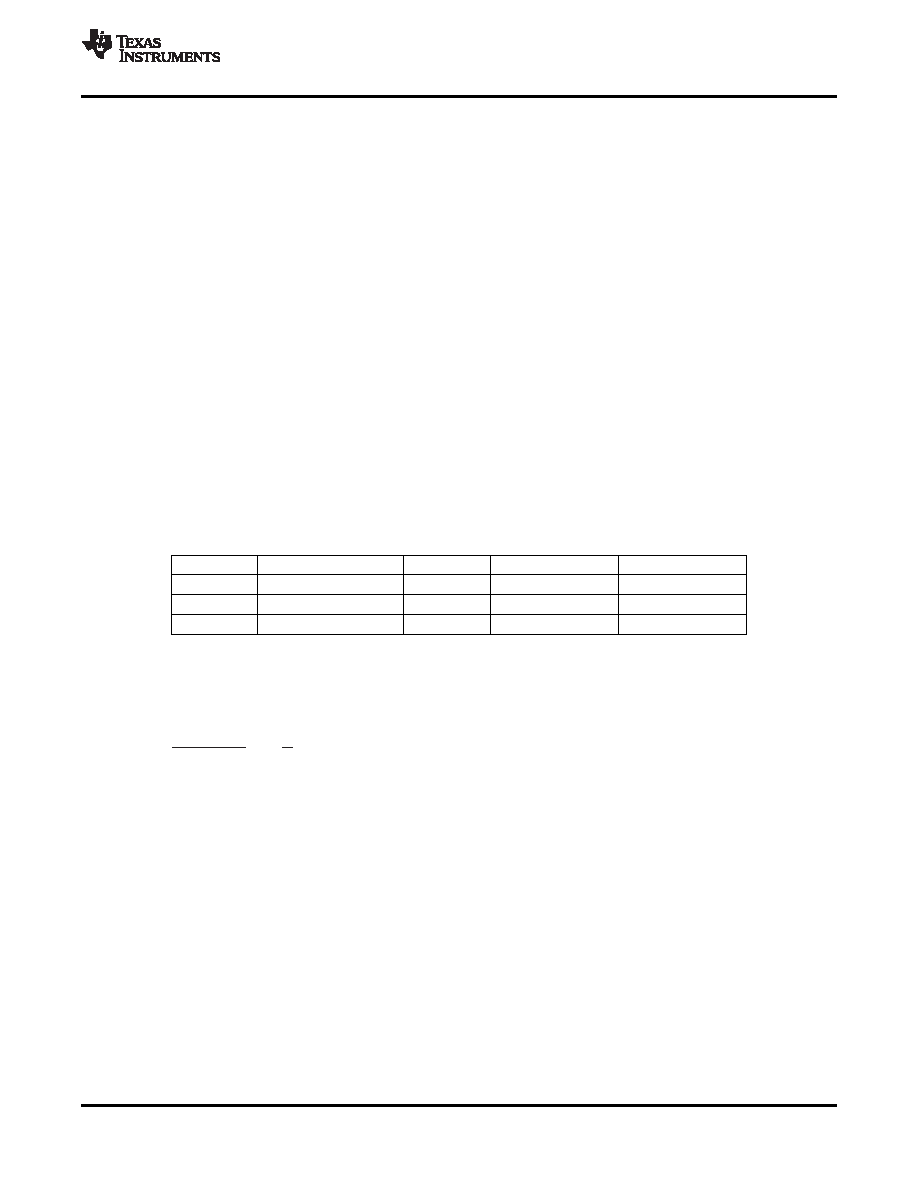- 您現在的位置:買賣IC網 > PDF目錄98270 > TPA2011D1YFFT (TEXAS INSTRUMENTS INC) 3.24 W, 1 CHANNEL, AUDIO AMPLIFIER, BGA9 PDF資料下載
參數資料
| 型號: | TPA2011D1YFFT |
| 廠商: | TEXAS INSTRUMENTS INC |
| 元件分類: | 音頻/視頻放大 |
| 英文描述: | 3.24 W, 1 CHANNEL, AUDIO AMPLIFIER, BGA9 |
| 封裝: | 1.21 X 1.16 MM, 0.40 MM PITCH, GREEN, PLASTIC, DSBGA-9 |
| 文件頁數: | 3/24頁 |
| 文件大小: | 670K |
| 代理商: | TPA2011D1YFFT |

Gain +
2 x 150 kW
R
I
V
www.ti.com
SLOS626A – DECEMBER 2009 – REVISED MAY 2010
APPLICATION INFORMATION
SHORT CIRCUIT AUTO-RECOVERY
When a short-circuit event occurs, the TPA2011D1 goes to shutdown mode and activates the integrated
auto-recovery process whose aim is to return the device to normal operation once the short-circuit is removed.
This process repeatedly examines (once every 100ms) whether the short-circuit condition persists, and returns
the device to normal operation immediately after the short-circuit condition is removed. This feature helps protect
the device from large currents and maintain a good long-term reliability.
INTEGRATED IMAGE REJECT FILTER FOR DAC NOISE REJECTION
In applications which use a DAC to drive Class-D amplifiers, out-of-band noise energy present at the DAC's
image frequencies fold back into the audio-band at the output of the Class-D amplifier. An external low-pass filter
is often placed between the DAC and the Class-D amplifier in order to attenuate this noise.
The TPA2011D1 has an integrated Image Reject Filter with a low-pass cutoff frequency of 130 kHz, which
significantly attenuates this noise. Depending on the system noise specification, the integrated Image Reject
Filter may help eliminate external filtering, thereby saving board space and component cost.
COMPONENT SELECTION
Figure 28 shows the TPA2011D1 typical schematic with differential inputs and Figure 29 shows the TPA2011D1
with differential inputs and input capacitors, and Figure 30 shows the TPA2011D1 with single-ended inputs.
Differential inputs should be used whenever possible because the single-ended inputs are much more
susceptible to noise.
Table 1. Typical Component Values
REF DES
VALUE
EIA SIZE
MANUFACTURER
PART NUMBER
RI
150 k
(±0.5%)
0402
Panasonic
ERJ2RHD154V
CS
1 mF (+22%, –80%)
0402
Murata
GRP155F50J105Z
CI
(1)
3.3 nF (±10%)
0201
Murata
GRP033B10J332K
(1)
CI is only needed for single-ended input or if VICM is not between 0.5 V and VDD – 0.8 V. CI = 3.3 nF
(with RI = 150 k) gives a high-pass corner frequency of 321 Hz.
Input Resistors (RI)
(1)
Resistor matching is very important in fully differential amplifiers. The balance of the output on the reference
voltage depends on matched ratios of the resistors. CMRR, PSRR, and cancellation of the second harmonic
distortion diminish if resistor mismatch occurs. Therefore, it is recommended to use 1% tolerance resistors or
better to keep the performance optimized. Matching is more important than overall tolerance. Resistor arrays with
1% matching can be used with a tolerance greater than 1%.
Place the input resistors very close to the TPA2011D1 to limit noise injection on the high-impedance nodes.
For optimal performance the gain should be set to 2 V/V or lower. Lower gain allows the TPA2011D1 to operate
at its best, and keeps a high voltage at the input making the inputs less susceptible to noise.
Decoupling Capacitors (CS1, CS2)
The TPA2011D1 is a high-performance class-D audio amplifier that requires adequate power supply decoupling
to ensure the efficiency is high and total harmonic distortion (THD) is low. For higher frequency transients,
spikes, or digital hash on the line, a good low equivalent-series-resistance (ESR) ceramic capacitor CS1 = 0.1mF ,
placed as close as possible to the device VDD lead works best. Placing CS1 close to the TPA2011D1 is important
for the efficiency of the class-D amplifier, because any resistance or inductance in the trace between the device
Copyright 2009–2010, Texas Instruments Incorporated
11
Product Folder Link(s) :TPA2011D1
相關PDF資料 |
PDF描述 |
|---|---|
| TPA2012D2RTJ | 2.1 W, 2 CHANNEL, AUDIO AMPLIFIER, PQCC20 |
| TPA2012D2YZH | 2.1 W, 2 CHANNEL, AUDIO AMPLIFIER, BGA16 |
| TPA2012D2RTJRG4 | 2.1 W, 2 CHANNEL, AUDIO AMPLIFIER, PQCC20 |
| TPA2012D2RTJR | 2.1 W, 2 CHANNEL, AUDIO AMPLIFIER, PQCC20 |
| TPA2012D2RTJTG4 | 2.1 W, 2 CHANNEL, AUDIO AMPLIFIER, PQCC20 |
相關代理商/技術參數 |
參數描述 |
|---|---|
| TPA2012D2 | 制造商:TI 制造商全稱:Texas Instruments 功能描述:2.1 W/CH STEREO FILTER-FREE CLASS-D AUDIO POWER AMPLIFIER |
| TPA2012D2_07 | 制造商:TI 制造商全稱:Texas Instruments 功能描述:2.1 W/CH STEREO FILTER-FREE CLASS-D AUDIO POWER AMPLIFIER |
| TPA2012D2EVM | 功能描述:音頻 IC 開發工具 TPA2012D2 Eval Mod RoHS:否 制造商:Texas Instruments 產品:Evaluation Kits 類型:Audio Amplifiers 工具用于評估:TAS5614L 工作電源電壓:12 V to 38 V |
| TPA2012D2PWP | 制造商:Texas Instruments 功能描述: |
| TPA2012D2PWPR | 制造商:Texas Instruments 功能描述: |
發布緊急采購,3分鐘左右您將得到回復。